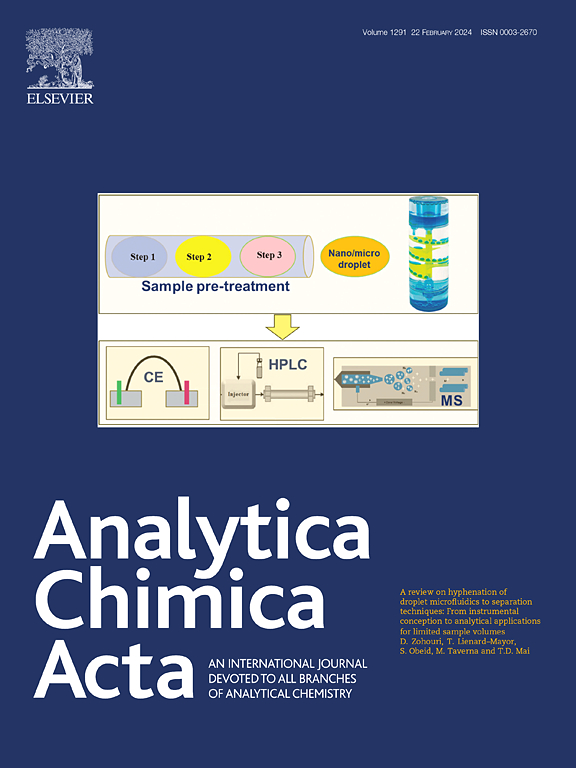磁性CRISPR/Cas12a-SERS纳米生物传感器用于水和食品样品中诺如病毒的无扩增和超灵敏检测
IF 6
2区 化学
Q1 CHEMISTRY, ANALYTICAL
引用次数: 0
摘要
诺如病毒(NoV)是世界范围内食源性疾病暴发的主要原因,通常通过受污染的食物和水传播。快速、灵敏、便携的NoV检测至关重要。本研究提出了一种磁性CRISPR/Cas12a-SERS纳米生物传感器,该传感器具有高灵敏度、高准确性、高速度和便携性。在这种纳米生物传感器中,SERS纳米探针通过连接单链dna (ssdna)与磁性纳米探针连接。NoV核酸的存在触发Cas12a的反式切割活性,降解连接体ssDNA。磁分离后,解离的SERS纳米探针与磁性纳米探针有效分离。这增强了上清液中的SERS信号,可使用便携式拉曼光谱仪检测。在60分钟内,NoV的检出限为100拷贝/mL。在实际环境中对纳米生物传感器进行了进一步评估,显示出在复杂食品样品中检测微量NoV的出色灵敏度和选择性。意义该方法不仅拓宽了基于crispr的病原体检测,而且为食源性病毒监测提供了可靠的工具。它的潜力不仅限于食品安全、环境监测和公共卫生部门,还有望加强对各种病原体的监测。本文章由计算机程序翻译,如有差异,请以英文原文为准。


A magnetic CRISPR/Cas12a-SERS nanobiosensor for amplification-free and ultrasensitive detection of norovirus in water and food samples
Background
Norovirus (NoV) is the leading cause of foodborne disease outbreaks worldwide, typically spreading via contaminated food and water. Rapid, sensitive, and portable detection of NoV is crucial.
Results
Here, we presented a magnetic CRISPR/Cas12a-SERS nanobiosensor capable of detecting NoV with high sensitivity, accuracy, speed, and portability. In this nanobiosensor, SERS nanoprobes linked to magnetic nanoprobes via linker single-stranded DNAs (ssDNAs). The presence of NoV nucleic acid triggered Cas12a′s trans-cleavage activity, degrading the linker ssDNA. After magnetic separation, the dissociated SERS nanoprobes were efficiently separated from the magnetic nanoprobes. This enhanced the SERS signal in the supernatant, detectable using a portable Raman spectrometer. The detection limit for NoV is 100 copies/mL within 60 min. The nanobiosensor was further assessed in real-world settings, demonstrating excellent sensitivity and selectivity for detecting trace NoV in complex food samples.
Significance
This approach not only broadens CRISPR-based pathogen detection but also provides a reliable tool for monitoring foodborne viruses. Its potential extends beyond NoV, promising enhanced surveillance of various pathogens in food safety, environmental monitoring, and public health sectors.
求助全文
通过发布文献求助,成功后即可免费获取论文全文。
去求助
来源期刊

Analytica Chimica Acta
化学-分析化学
CiteScore
10.40
自引率
6.50%
发文量
1081
审稿时长
38 days
期刊介绍:
Analytica Chimica Acta has an open access mirror journal Analytica Chimica Acta: X, sharing the same aims and scope, editorial team, submission system and rigorous peer review.
Analytica Chimica Acta provides a forum for the rapid publication of original research, and critical, comprehensive reviews dealing with all aspects of fundamental and applied modern analytical chemistry. The journal welcomes the submission of research papers which report studies concerning the development of new and significant analytical methodologies. In determining the suitability of submitted articles for publication, particular scrutiny will be placed on the degree of novelty and impact of the research and the extent to which it adds to the existing body of knowledge in analytical chemistry.
 求助内容:
求助内容: 应助结果提醒方式:
应助结果提醒方式:


